The right time tracking solution can make work easier for you by replacing boring spreadsheets and paperwork with powerful automation and workflow optimization.
Two such popular solutions are Harvest and Everhour. They offer a range of features, from time tracking to payroll management.
So how do they compare?
Find all the answers in this Everhour and Harvest review.
In this article, we’ll compare Harvest vs Everhour to help you choose the best tool. We’ll also highlight a better alternative to boost your profitability and productivity.
Let’s begin!
Harvest vs Everhour: An overview
Before we get into the details, here’s a quick summary of the main differences between Harvest and Everhour:
| Features | Harvest | Everhour |
| Time tracking | Automatic and manual | Automatic and manual |
| Idle time tracking | Yes | Yes |
| Attendance tracking | No | Yes |
| Advanced reporting | 4+ | 6+ |
| Integrations | 60+ | 30+ |
| Platform availability | Mac, Windows, Android, iOS, and Chrome | Mac, Windows, Android, iOS, and Chrome |
| Pricing | $12/user per month | Starts from $6/user per month |
Harvest vs Everhour: An in-depth comparison
Now let’s take a closer look at these differences.
1. Tool overview
Here’s a brief overview of the two tools:
A. Harvest
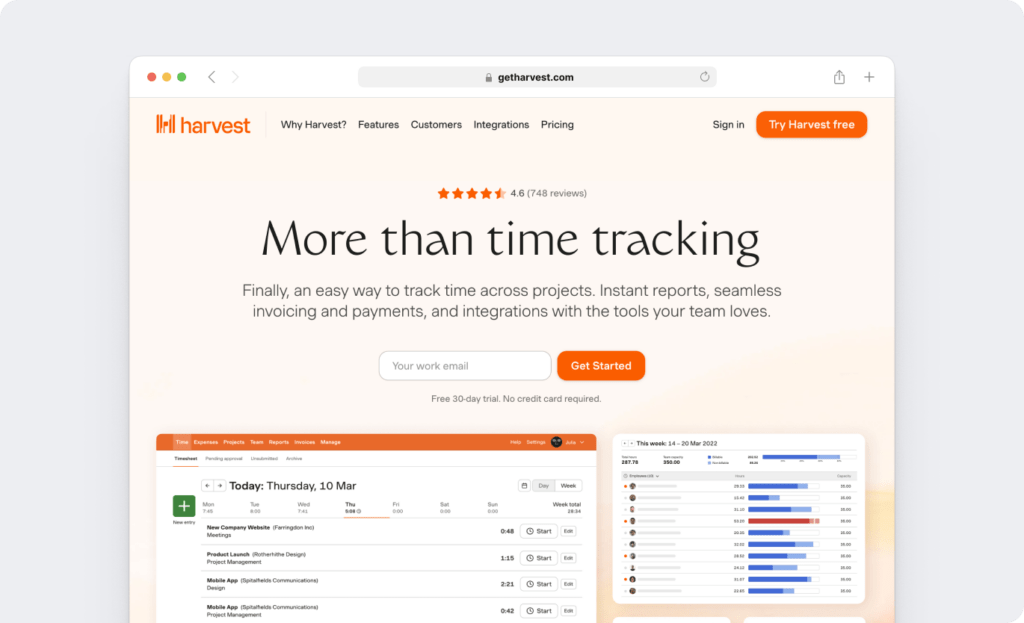
Harvest is a cloud-based time tracking software suitable for a freelancer and businesses of all kinds. It helps track and optimize the productivity of your business teams.
Some features of this software are:
- Track time with a single click.
- Visualize your project progress through detailed reporting.
- Generate invoices for each billable work hour.
The desktop app supports Mac, Windows, and Linux, while the mobile app supports iPhone (iOS) and Android devices. It also offers a Chrome extension.
Customer ratings
- G2: 4.3/5 (775+ reviews)
- Capterra: 4.6/5 (540+ reviews)
B. Everhour
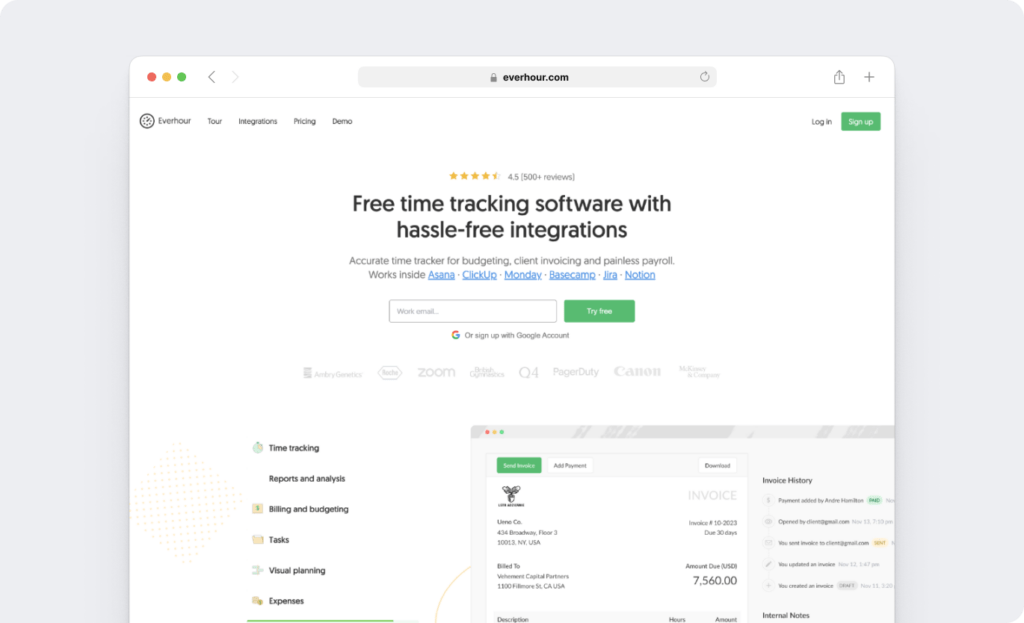
Everhour is a simple time tracking and productivity management tool suitable for a freelancer and small business owners. It provides manual time tracking, invoicing, and powerful integrations to help you monitor your team’s productivity.
Other Everhour features are:
- Track project progress with its clock-in and clock-out timer.
- Gain actionable insights, like total hours worked, into your projects and team members.
- Create custom invoices with employee time tracking data.
Customer ratings
- G2: 4.7/5 (145+ reviews)
- Capterra: 4.7/5 (360+ reviews)
With the basics out of the way, let’s compare the features.
2. Time tracking
Here’s how Harvest and Everhour track each employee’s work hours:
A. Harvest
Harvest offers two time tracking features:
1. Billable hours tracking
Harvest has a daily timer your employees can use to track time. All they have to do is press ‘Start’ when they begin work and ‘Stop’ when they finish their work hours.
This gives you a clear picture of how your employees spend their work hours. You can also use it to check if your employees are overworking or underworking.
For example, if an employee spends around 60 hours when you’ve assigned 30 work hours, the tool will indicate employee burnout.
Harvest also offers a timesheet feature that lets you:
- Add time entries for the whole week in bulk.
- See your tracked time data for the entire week.
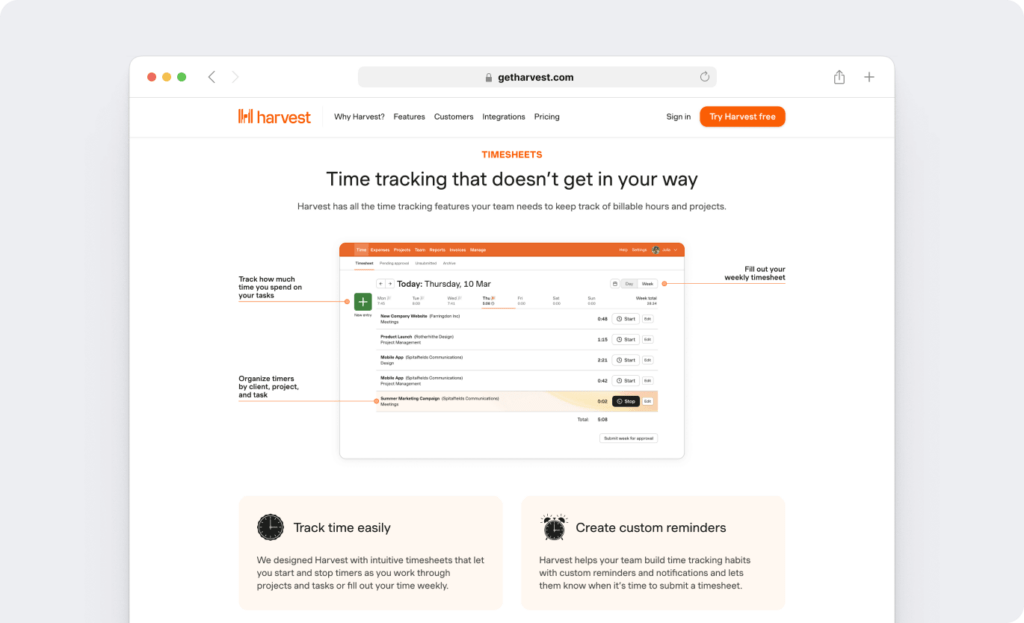
2. Offline time tracking
If you lose internet connection while tracking time on a Harvest browser or desktop app, the timer will continue to track time. You can only stop the timer or edit your time entry once you get back online.
Harvest also offers offline time tracking mode on Android and iPhone mobile devices. Here, you can manually enter the time on your mobile app. The tool will sync the time entries when you’re back online.
A. Everhour
Everhour has three different ways to track time:
1. Manual time tracking
Employees can track their work hours using the task management software’s simple clock-in and clock-out features.
To log in, employees can press ‘clock-in’ and select ‘clock-out’ to sign out after their work hours.
Employees can also track time from the Everhour webpage.
They can log into their accounts, find the task they want to track time for, and choose ‘clock-in’ or ‘clock-out’ accordingly.
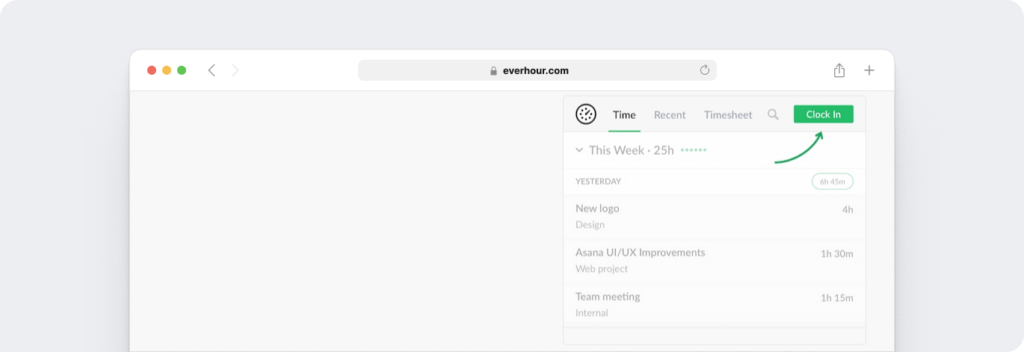
2. Timesheet management
Besides showing the tracked data of different tasks for the week, with timesheets, employees can:
- Click on a particular task to add or edit work hours.
- Select the ‘Add Row’ button to add a new task and its work time.
This ensures that all time and work is recorded even if employees forget to clock in and out using the Everhour timer.
For employees who don’t need to track specific time spent under each project, Everhour offers a Timecards feature. They can simply click ‘clock in’ for a specific weekday, like Monday or Tuesday, and ‘clock out’ when they are done.
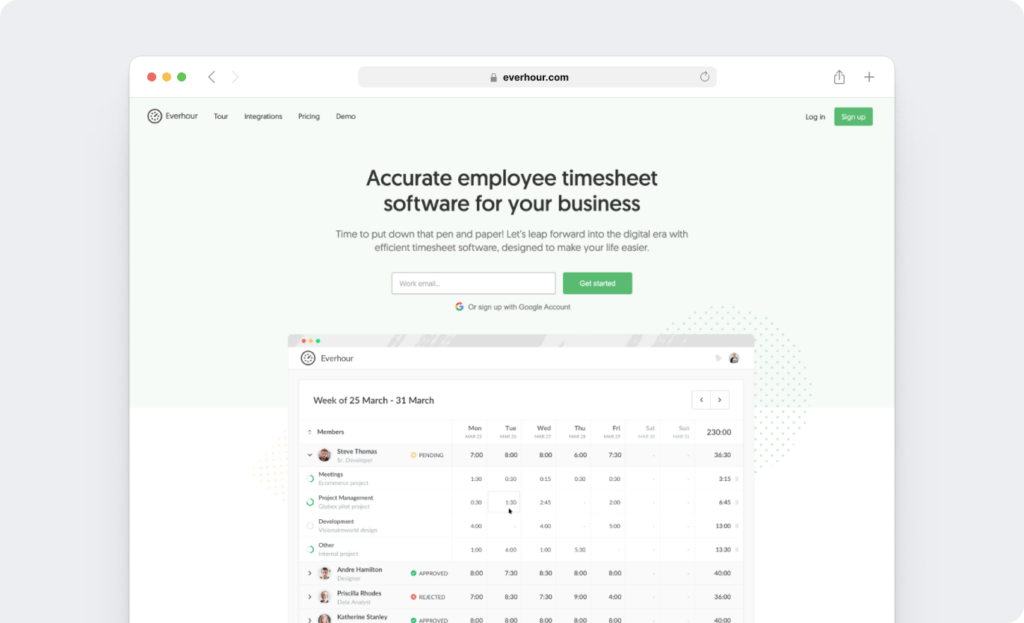
3. Productivity management
Productivity management is essential for any business looking to optimize its operations.
Let’s compare Harvest and Everhour’s productivity management features:
A. Harvest
Here’s how Harvest helps you manage productivity:
1. Idle time tracker
The software tracks mouse movements and keystrokes to track time. So if there are no mouse or keyboard movements for a predetermined time, the time tracker starts tracking idle time.
The tool lets you choose what to do with the tracked idle time.
For example, if you select ‘stop the timer and remove X minutes’, the timer will stop, and the tool will remove the idle time from the total time data.
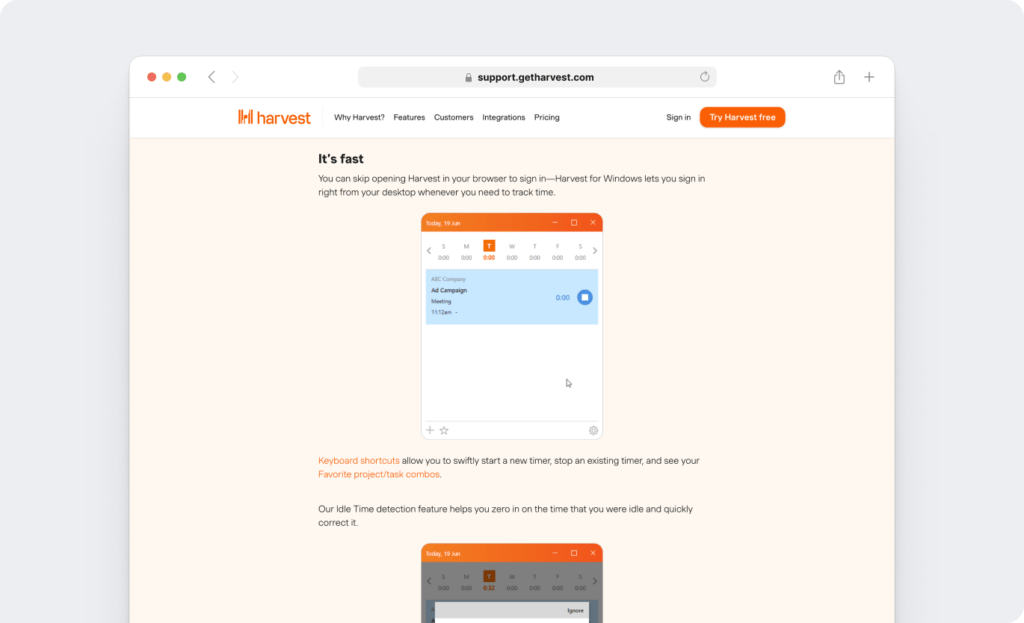
2. Team overview
Team overview lets you see how your employees perform weekly. For instance, it helps you find out if your team is overworking themselves or clocking in the required hours.
Whether you have on-site or remote work employees, Team overview lets you see:
- Summary information: Shows information like your team’s total capacity, billable hours, and more.
- Team member information: Offers each employee’s tracked time data and capacity. You can also view who’s running the timer in real time.
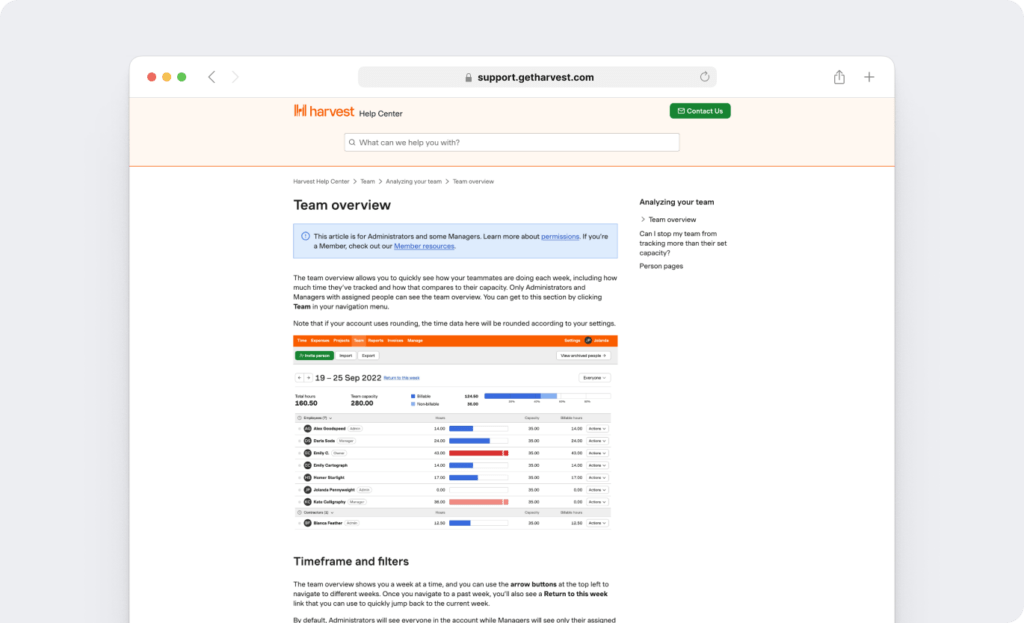
Note: Administrators can see all employees’ weekly overviews, while managers can only view the ones assigned to them.
B. Everhour
Everhour helps you manage productivity effortlessly with its idle time feature. If the tool tracks inactivity for 15 minutes, the app automatically clocks you out. The tool will also stop if your computer goes into a locked or sleep mode.
But if this is inconvenient, the tool lets you choose between automatic clock-out based on your idle time or work hours.
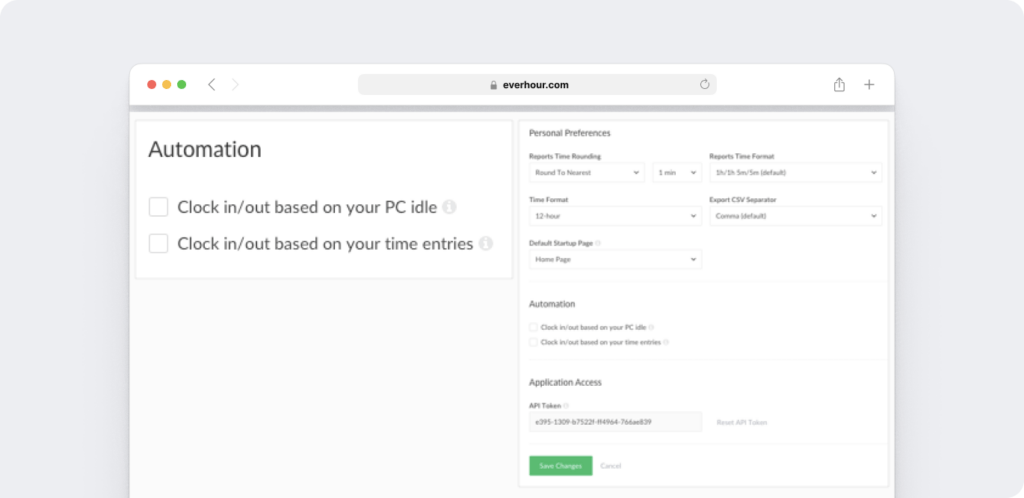
4. Attendance and leave tracking
Here’s how these time and task management tools track attendance and time offs:
A. Harvest
Although Harvest doesn’t have an inbuilt tool for leave tracking, here are some other ways you can track time off on the tool:
- You can open separate non-billable tasks for vacations, paid time off, and more.
- You can also create an internal, non-billable project for each employee. This will allow you to create the vacation or emergency leaves as separate tasks.
You can then assign each employee their respective vacation hours so that they know how much “time offs” they have left.
B. Everhour
Everhour uses the tracked time data to generate attendance reports.
Additionally, the tool provides an optional ‘time off’ feature, where employees can create and request time offs. The admins can add or remove the feature from the tool’s interface.
Although members don’t need the admin’s approval to create time off, they need approval when requesting leave or time off.
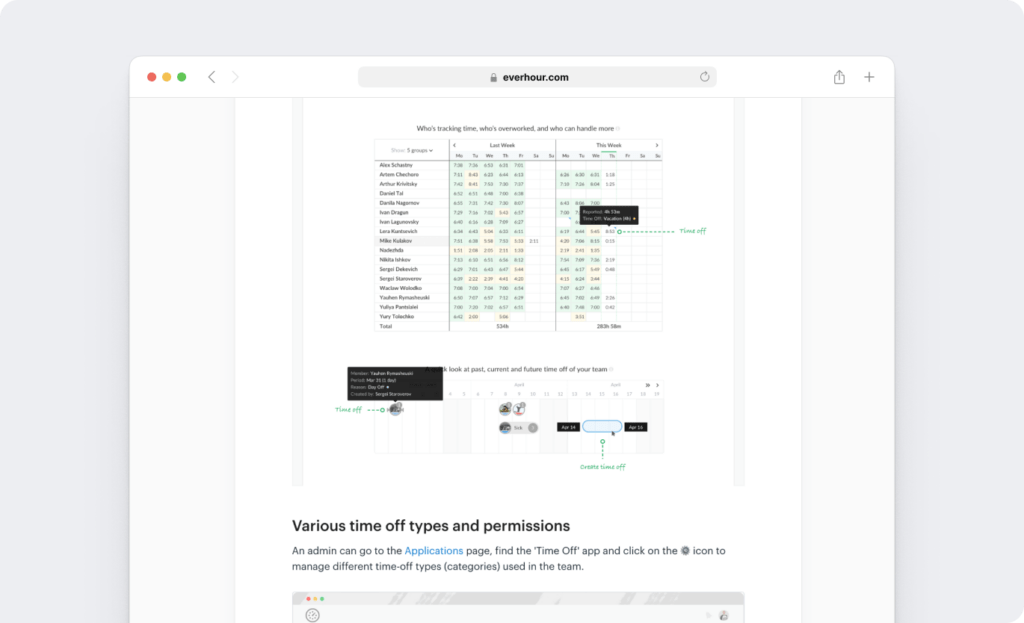
5. Project management
Let’s look at how these time tracking tools track time for projects:
A. Harvest
With the Harvest time tracking app, you can see how much time each employee spends on a project, set project budgets, and improve project management.
The app also gives you a breakdown of each employee or task’s time tracking data. This will give you a better understanding of projects, like which task or employee takes more time.
You can use this information to estimate future similar projects. It lets you optimize employee scheduling and allocate appropriate project budgets.
B. Everhour
The time and project management software offers a project tab with three helpful features:
- Create tasks and projects.
- View projects on the board and list views.
- Organize tasks into sections and add tags like month or year.
The projects tab also shows all existing projects, which you can categorize as billable or non-billable.
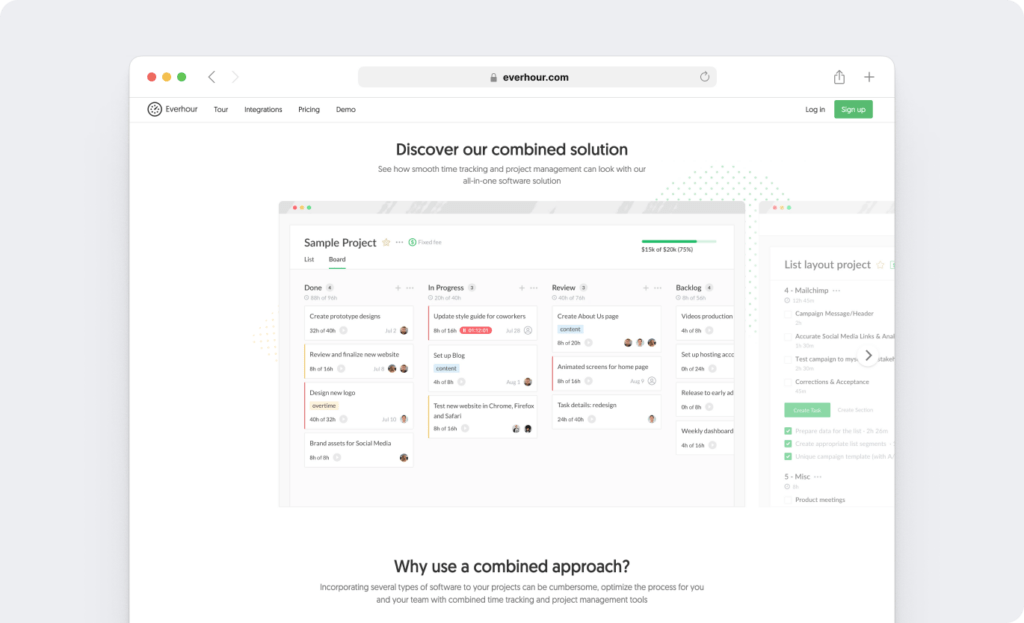
6. Reporting
Let’s check out the reports generated by the time tracking tools:
A. Harvest
This time tracking software converts tracked time data into insightful reports that give accurate information about your team’s expenses, time entries, project budgets, and more.
Some of these reports are:
- Expense reports: Generates detailed expense tracking reports for employees, clients, and projects.
- Invoice report: Shows a list of invoices issued during a specific period.
- Contractor reports: Displays all active contractors, along with their total hours and costs.
- Detailed time report: Calculates the hours and billable information for individual clients, projects, tasks, and employees.
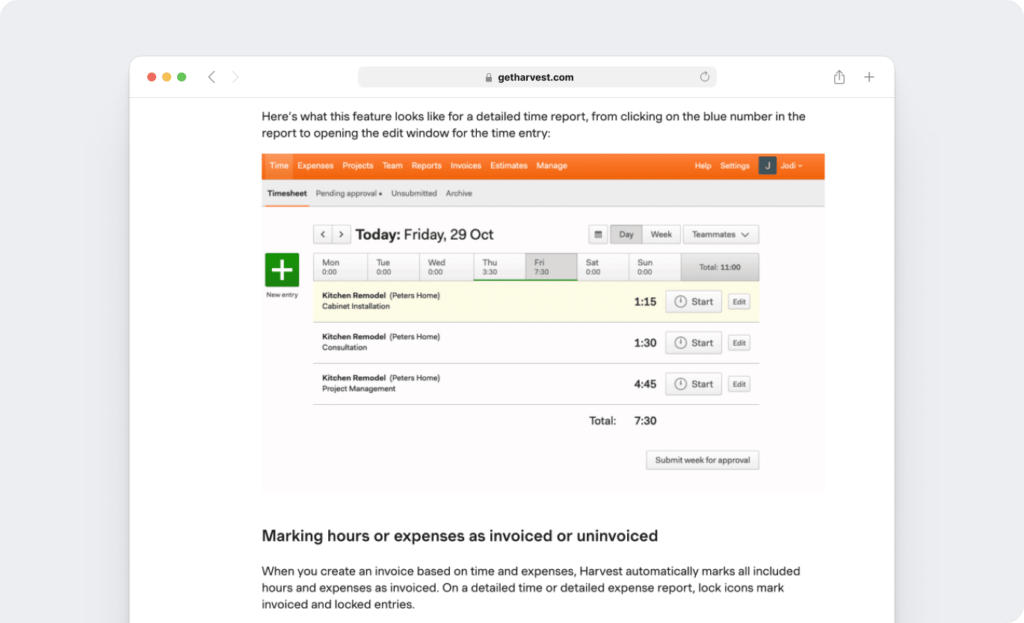
B. Everhour
The time tracking app provides reports such as:
- Team timesheet: Shows how each member spends their time.
- Member profile: Summarizes each employee’s work, top tasks, and detailed time entry.
- Project summary: Shows the time and money spent on individual projects.
You can create custom reports by adding or deleting columns and applying filters. You can also send these reports to your employees or clients via email.
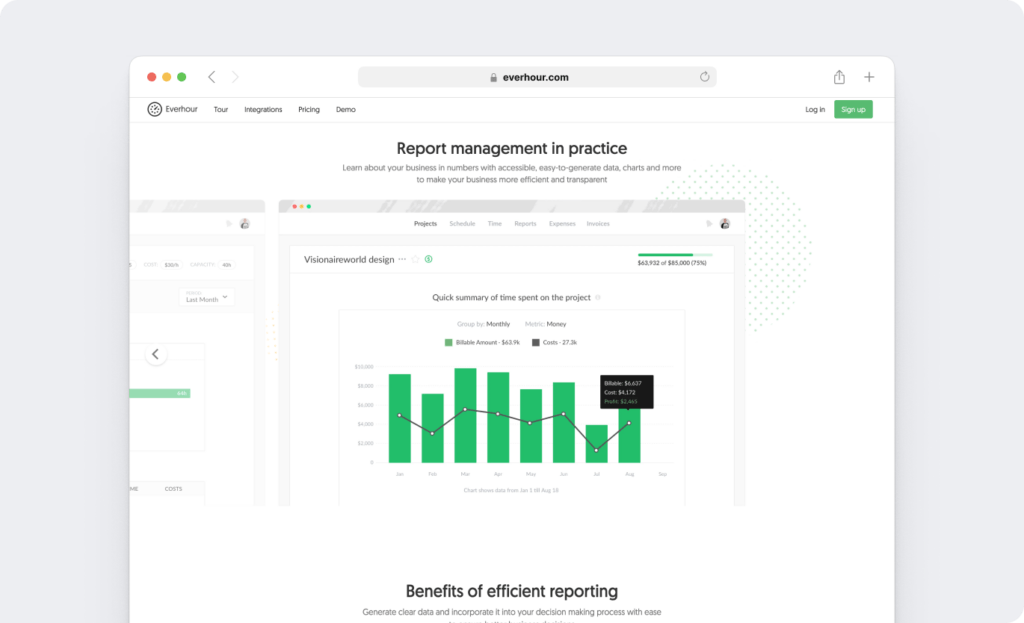
7. Invoicing and payroll
Here’s how Harvest and Everhour offer invoicing and payroll features:
A. Harvest
Harvest lets you convert all tracked billable time and expense tracking data into an invoice.
You can then send these invoices to your clients and also set up late payment reminders according to predetermined timeframes. The tool also offers integration with apps like Stripe and Paypal, which means clients can immediately pay your invoices.
You can also create customizable free-form invoices if you need to add or remove any invoicing information.
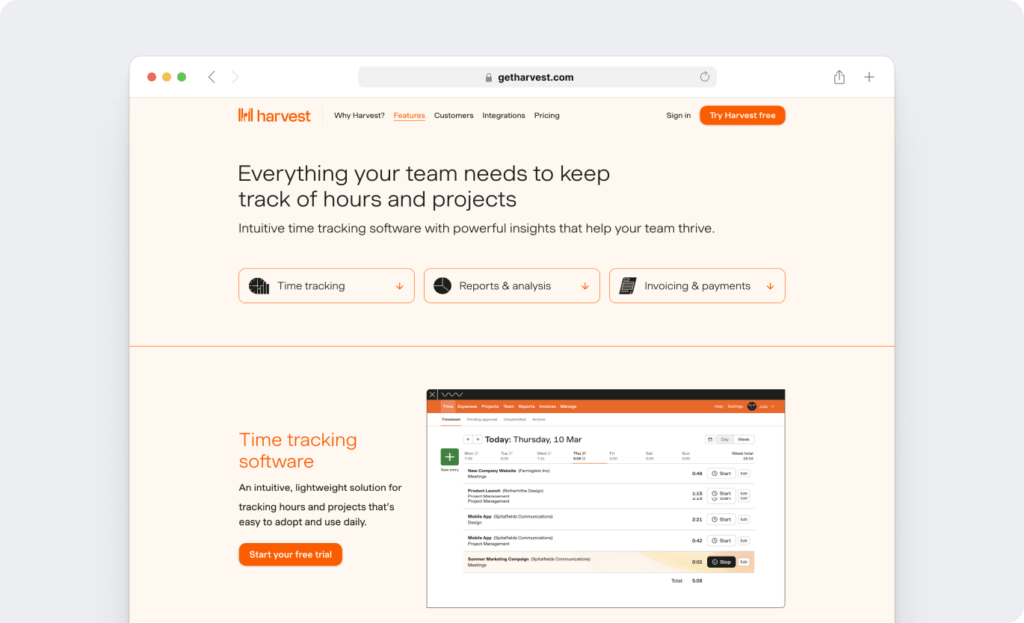
B. Everhour
The time management software generates customized invoices based on employee time tracking data. It also integrates with apps like Quickbooks and Xero to simplify billing.
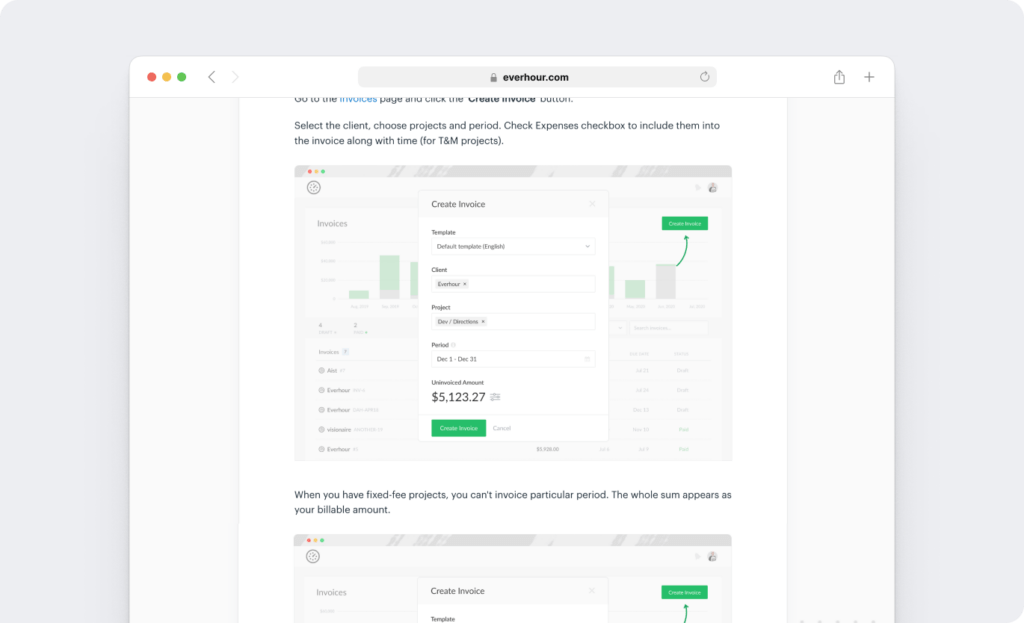
8. Integrations
Here are a few integrations Harvest and Everhour offer:
A. Harvest
Harvest time tracking software has 60+ integrations. Some of them are:
- Project management: Jira, Asana, Zapier, Trello, ClickUp
- Calendars: Google Calendar, Outlook
- Invoicing and payroll: QuickBooks, PayPal, Stripe
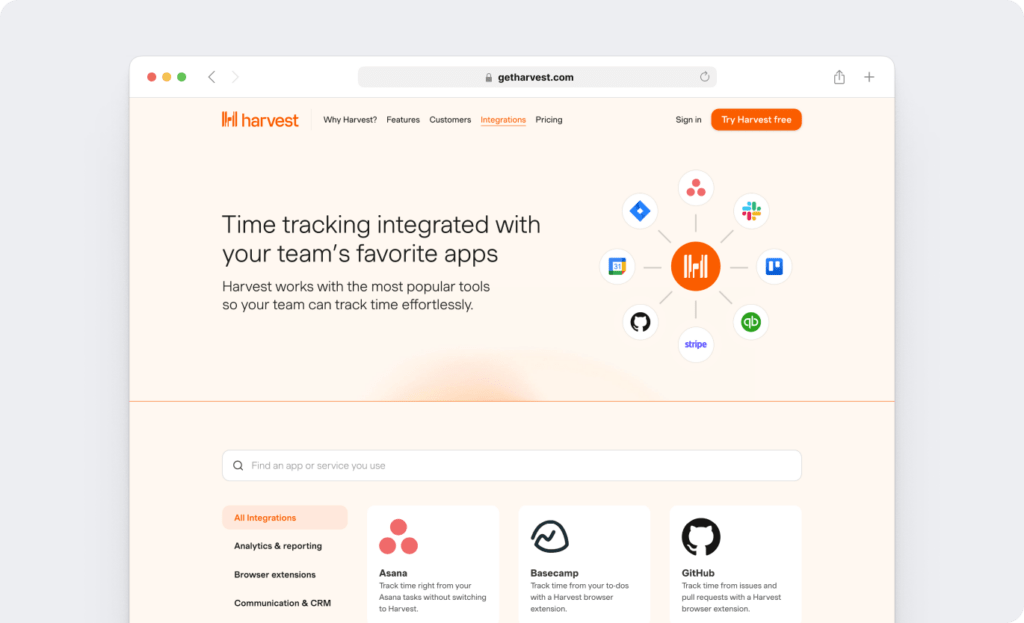
B. Everhour
Everhour has 20+ various native and website integrations, so you don’t have to switch between apps while tracking time.
A few of these integrations are:
- Project management: Asana, Basecamp, ClickUp
- Accounting software: Xero, QuickBooks, FreshBooks
- CRM: Insightly
- Communication tools: Slack
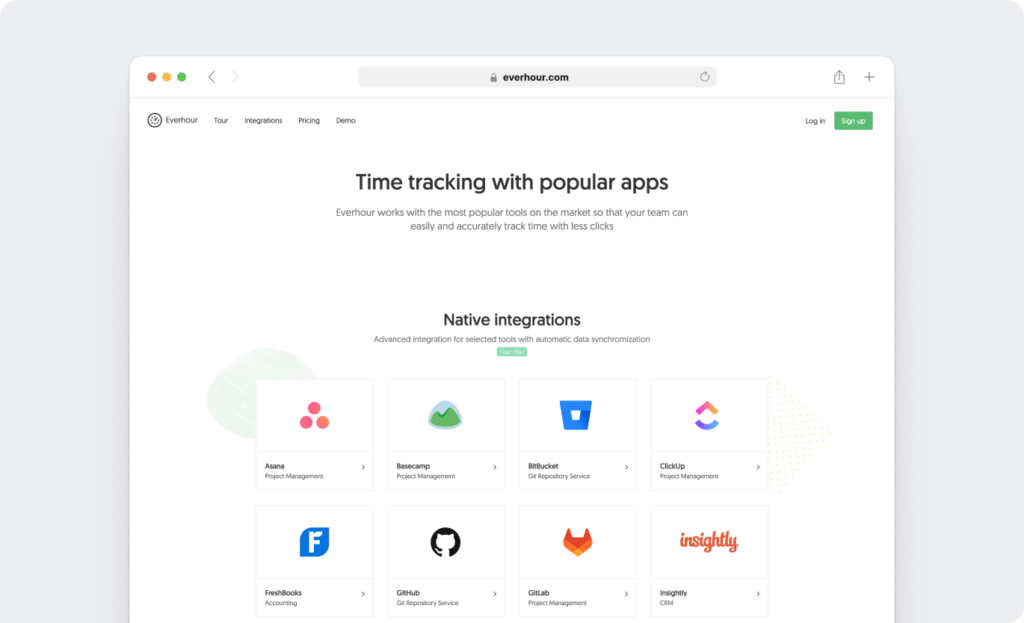
9. Pricing
Let’s explore the pricing of the two tools.
A. Harvest
Harvest offers a free plan for a single user with 2 projects. Its paid plan, Harvest Pro, is priced at $12/user per month.
B. Everhour
Everhour provides a free plan for five users with unlimited projects. Its paid plans start from $6/user per month.
Although both these tools offer user-friendly features, they come with some drawbacks too. Let’s check out a few things you should consider before making your choice.
2 limitations of Harvest and Everhour
Here are some limitations of Harvest and Everhour that affect your project management:
- Productivity ratings: Productivity ratings help classify the websites and apps used by employees during work hours as productive and unproductive. Neither tools offer this feature, which may make it challenging to track employee productivity.
- Limited reporting capabilities: Harvest and Everhour offer limited productivity reports. For example, Harvest only offers just 4 types of reports. This may affect productivity management as you won’t have enough insights to make good business decisions.
Looking for more options?
Let’s check out a powerful Harvest and Everhour alternative that might suit your business better.
Time Doctor: The best Harvest and Everhour alternative
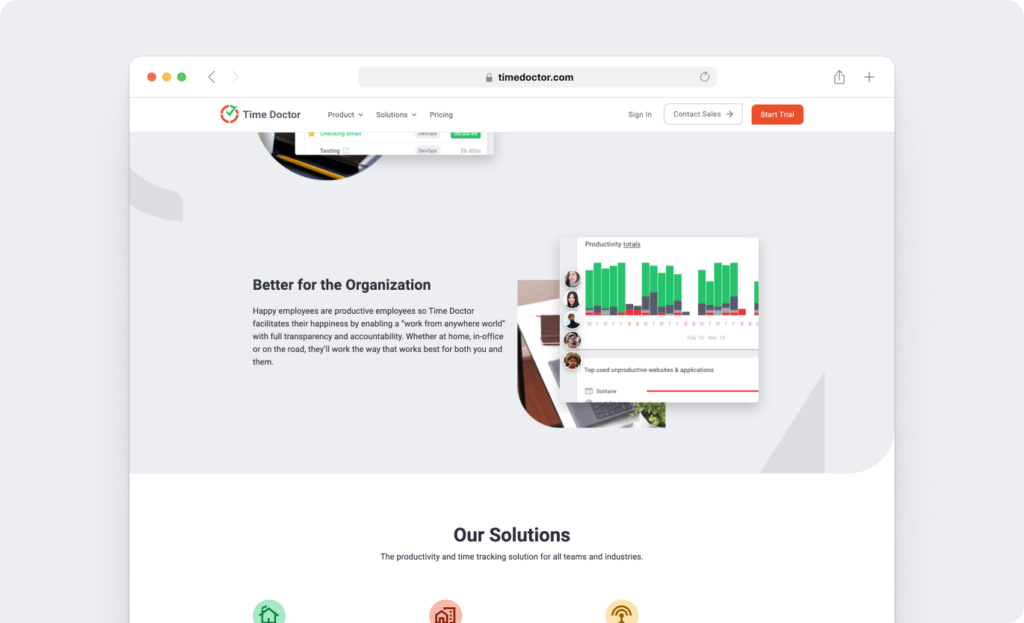
Time Doctor is a powerful time tracking and productivity management tool. It helps major companies, like Ericsson, and small business teams, like Thrive Market, skyrocket their productivity.
The tool offers:
- Two modes of time tracking — manual and automatic.
- Comprehensive reports to get valuable insights.
- Web and app productivity ratings to see how your employees spend their work hours, and more.
Discover all of Time Doctor features here.
But how much does Time Doctor cost?
Time Doctor offers a 14 day trial without needing any credit card information. Its paid plans start from $7/user per month.
Wrapping up
Harvest offers simple time and attendance tracking features, while Everhour provides excellent project management and integrations to track time across multiple platforms.
However, both these tools don’t offer comprehensive productivity management and reporting features like Time Doctor.
Time Doctor provides powerful automation, time tracking, and productivity features that help optimize business workflows and boost productivity.
So why not sign up for Time Doctor’s free trial and experience the transformation yourself?


